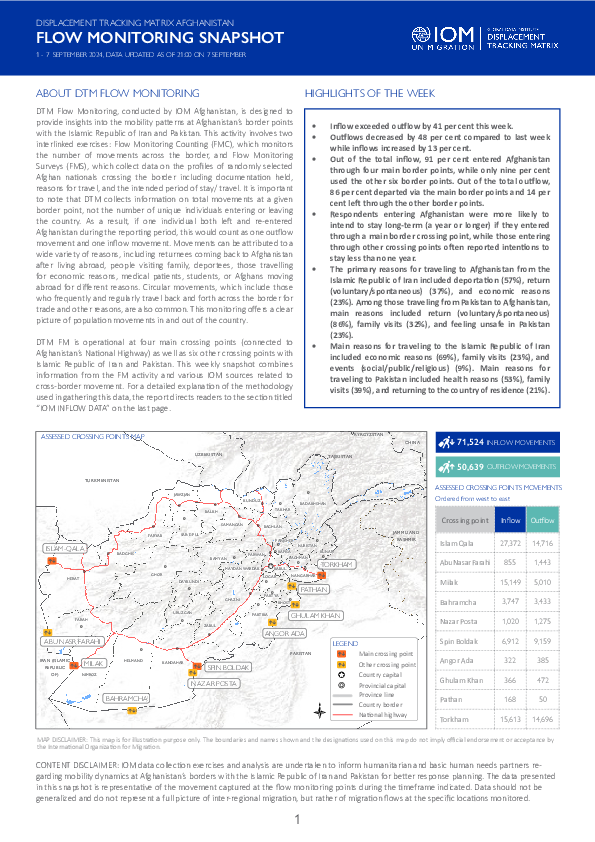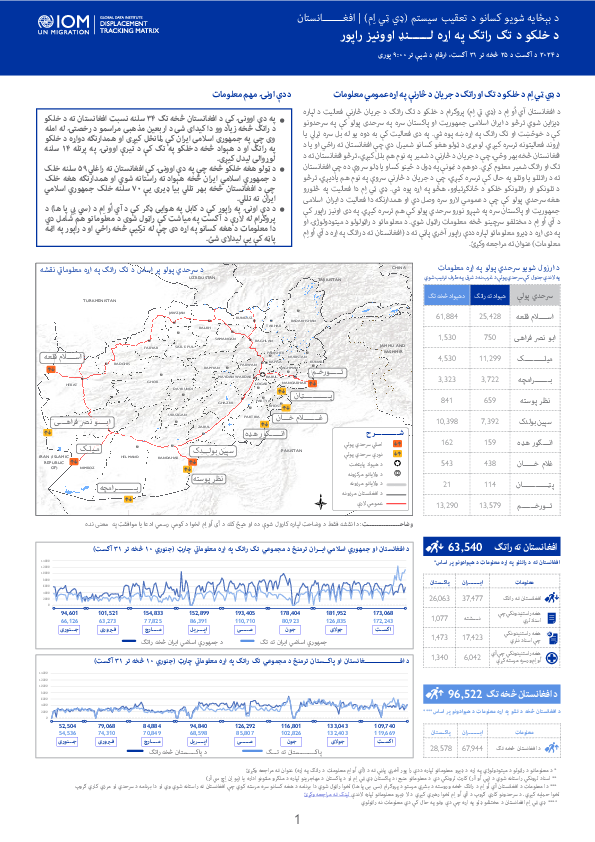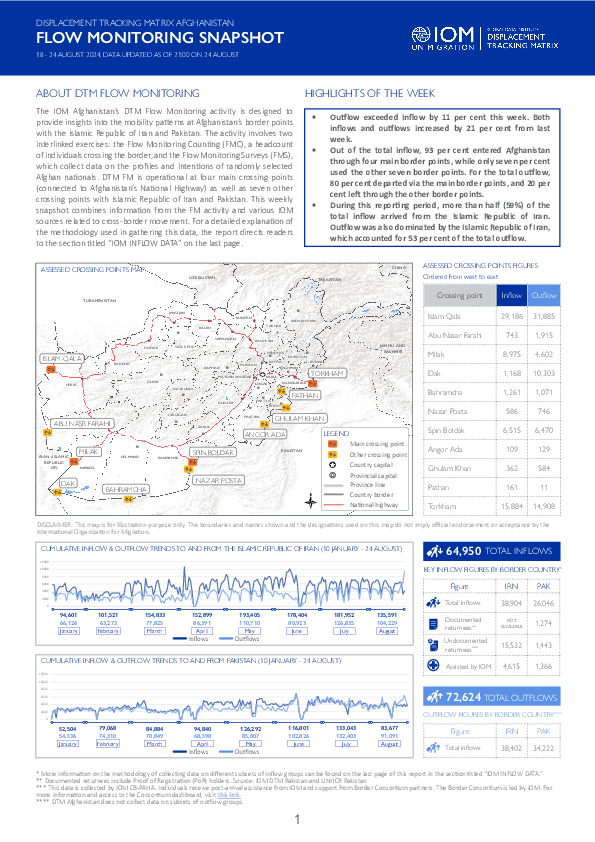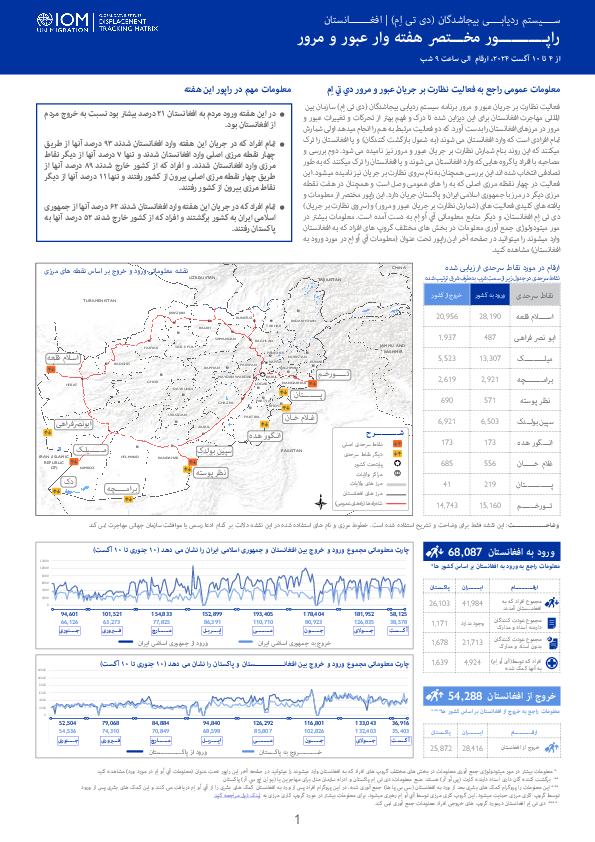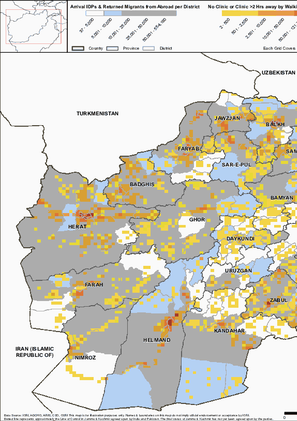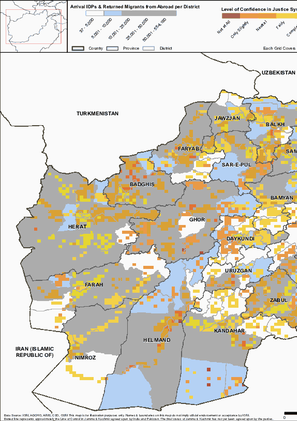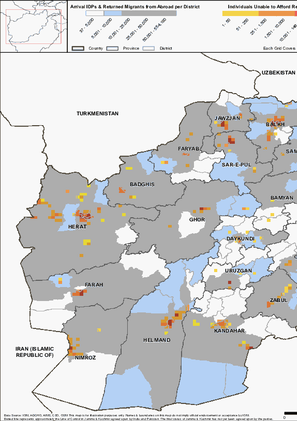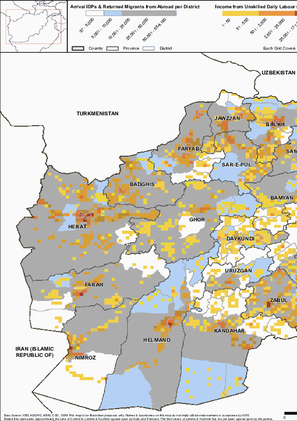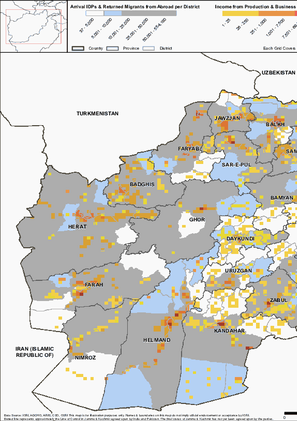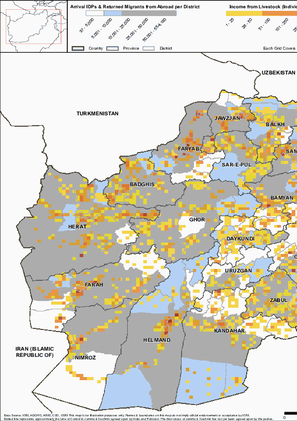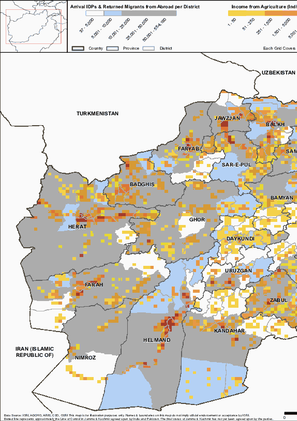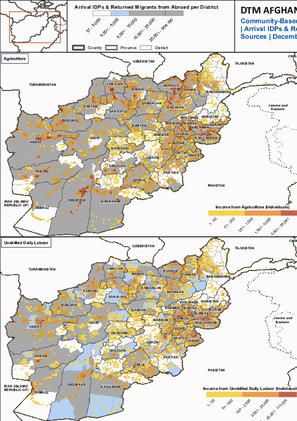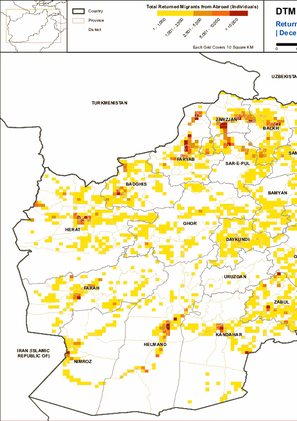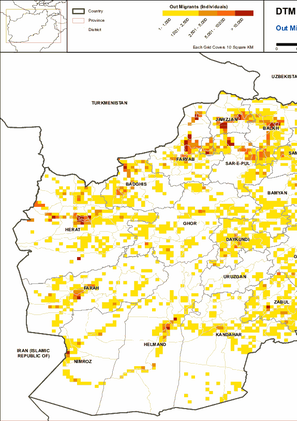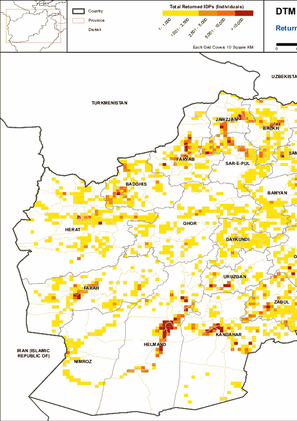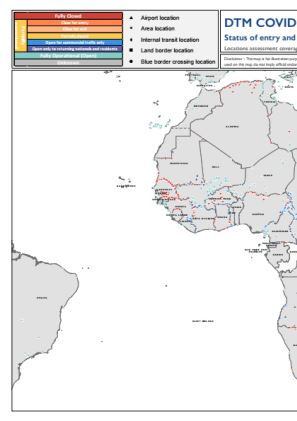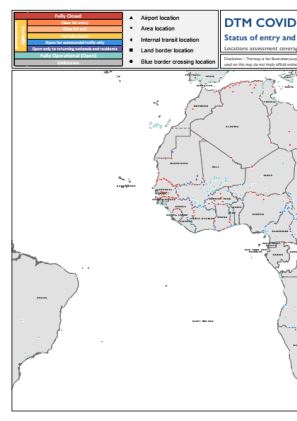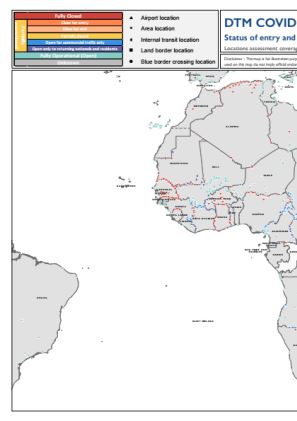-
Countries
-
Data and Analysis
-
Special Focus
-
Crisis Responses
Afghanistan
Afghanistan
Desplazados internos rastreados
Movimientos de desplazamiento
4,187,000
IDMC 2023
Ronda de recopilación de datos
Sobre Afghanistan
The Displacement Tracking Matrix (DTM) is an information management system of tools and methodologies used to track and monitor displacement and population mobility. In Afghanistan, IOM activated the DTM programme in January 2017 in response to the substantial increase of Afghans returning home from neighbouring countries, as well as record levels of internal displacement. DTM in Afghanistan is designed to regularly and systematically capture, process and disseminate multi-layered information about the population sizes, locations, geographic distribution, movements, vulnerabilities, evolving multisectoral needs, and the drivers of migration of returnees, IDPs, migrants and mobile populations. DTM implements baseline mobility assessments, flow monitoring, registrations, and various migration surveys to provide an essential evidence base that enables decision-makers and humanitarian, reintegration and development partners to maximize resources and deliver efficient, better-targeted, mobility-sensitive and sustainable humanitarian; reintegration, community stabilization and development programming.
The value-added impact of DTM in Afghanistan is to inform action and results for people in need. DTM Afghanistan implements its activities at both the national and provincial levels. DTM works closely with other (IOM) programmes through referring identified populations in need of assistance at flow monitoring points to IOM’s Cross Border Return and Reintegration, Protection, Humanitarian Assistance, and Reintegration and Development (RADA) programmes. DTM Afghanistan also supports humanitarian partners and clusters, including WFP, FAO, UNHCR, IRC, DRC, NRC, and WHO, among many others, by providing emergency tracking updates in large-scale or sudden onset movements, such as emergency event tracking and drought response. Furthermore, stabilization and development actors, including IOM’s RADA programme, and the World Bank leverage DTM’s information to select priority communities and districts with higher concentrations of IDPs and returnees to receive reintegration and livelihoods assistance and improvements to core infrastructure and essential services. In support of health partners, including WHO, UNICEF, and the Humanitarian Health Cluster, DTM data informs the selection of priority, at-risk districts, border areas, communities, and health facilities in need of strengthened capacity, response, surveillance, and risk education for polio, TB, COVID-19, and other infectious diseases.
Contacto
Modher ALHAMADANI
Senior Programme Coordinator - DTM
malhamadani@iom.int
DTM AFGHANISTAN
DTMAFGHANISTAN@iom.int
Current Donors
- Republic of Korea
- Norway
- CERF
- Canada
- Italy
- EU
- FCDO
Para obtener resultados de búsqueda más avanzados, vaya a la Página de búsqueda avanzada de informes
Afghanistan - Flow Monitoring Snapshot (22 - 28 September 2024) [ENG]
DTM Flow Monitoring, conducted by IOM Afghanistan, is designed to provide insights into the mobility patterns at Afghanistan’s border points with the Islamic Republic of Iran and Pakistan.
افغانستان - د خلکو د تګ او راتګ په اړه لنډ راپور (۱۵ - ۲۱ سپتمبر ۲۰۲۴) [PASHTO]
د افغانستان آي اُو اِم د (ډي تي اِم) پروګرام د خلکو بهر ته د سفر او بیرته راتګ د جریان د څارنې فعالیت ددې لپاره ډیزاین شوي ترڅو د جمهوري اسلامي ایران او پاکستان هېواد سره په سرحدي پولو کې د خلکو د سفر، تګ او راتګ په اړه ښه معلومات وړاندې کړي او ښه پوه شي.
افغانستان - راپور مختصر جریان عبور و مرور (۱۵ - ۲۱ سپتمبر ۲۰۲۴) [DARI]
فعالیت نظارت بر جریان عبور و مرور مردم برنامه سیستم ردیابی بیجاشدگان (دی تی اِم) سازمان بین المللی مهاجرت افغانستان برای این دیزاین شده است تا معلومات و درک بهتر از تحرکات و عبور و مرور مردم در مرزهای افغانستان را بدست آورد.
Afghanistan - Flow Monitoring Snapshot (15 - 21 September 2024) [ENG]
DTM Flow Monitoring, conducted by IOM Afghanistan, is designed to provide insights into the mobility patterns at Afghanistan’s border points with the Islamic Republic of Iran and Pakistan.
افغانستان - د خلکو د تګ او راتګ په اړه لنډ راپور (۸ - ۱۴ سپتمبر ۲۰۲۴) [PASHTO]
د افغانستان آي اُو اِم د (ډي تي اِم) پروګرام د خلکو بهر ته د سفر او بیرته راتګ د جریان د څارنې فعالیت ددې لپاره ډیزاین شوي ترڅو د جمهوري اسلامي ایران او پاکستان هېواد سره په سرحدي پولو کې د خلکو د سفر، تګ او راتګ په اړه ښه معلومات وړاندې کړي او ښه پوه شي.
افغانستان - راپور مختصر جریان عبور و مرور مردم (۸ - ۱۴ سپتمبر ۲۰۲۴) [DARI]
فعالیت نظارت بر جریان عبور و مرور مردم برنامه سیستم ردیابی بیجاشدگان (دی تی اِم) سازمان بین المللی مهاجرت افغانستان برای این دیزاین شده است تا معلومات و درک بهتر از تحرکات و عبور و مرور مردم در مرزهای افغانستان را بدست آورد.
Afghanistan - Flow Monitoring Snapshot (8 -14 September 2024) [ENG]
DTM Flow Monitoring, conducted by IOM Afghanistan, is designed to provide insights into the mobility patterns at Afghanistan’s border points with the Islamic Republic of Iran and Pakistan.
افغانستان - د خلکو د تګ او راتګ په اړه لنډ راپور (۱ - ۷ سپتمبر۲۰۲۴) [PASHTO]
د افغانستان آي اُو اِم د (ډي تي اِم) پروګرام د خلکو د تګ او راتګ د جریان د څارنې فعالیت ددې لپاره ډیزاین شوي ترڅو د جمهوري اسلامي ایران او پاکستان هېواد سره په سرحدي پولو کې د خلکو د سفر، تګ او راتګ په اړه ښه معلومات وړاندې کړي او ښه پوه شي.
افغانستان - راپور مختصر جریان عبور و مرور (۱- ۷ سپتمبر۲۰۲۴) [DARI]
فعالیت نظارت بر جریان عبور و مرور برنامه سیستم ردیابی بیجاشدگان (دی تی اِم) سازمان بین المللی مهاجرت افغانستان برای این دیزاین شده تا معلومات و درک بهتر از تحرکات و تغییرات عبور و مرور مردم در مرزهای افغانستان را بدست آورد.
Afghanistan - Flow Monitoring Snapshot (1-7 September 2024) [ENG]
DTM Flow Monitoring, conducted by IOM Afghanistan, is designed to provide insights into the mobility patterns at Afghanistan’s border points with the Islamic Republic of Iran and Pakistan.
افغانستان - د خلکو د تګ راتګ په اړه لنډ راپور (۲۵ - ۳۱ آگست ۲۰۲۴) [PASHTO]
د افغانستان آي اُو اِم د (ډي تي اِم) پروګرام د خلکو د تګ راتګ د جریان څارنې فعالیت د لپاره ډیزاین شوي ترڅو د ایران اسلامی جمهوریت او پاکستان سره په سرحدی پولو کې په سرحدونو کې د خوځښت او تګ راتګ په اړه ښه پوه شي.
افغانستان - راپور مختصر جریان عبور و مرور (۲۵ - ۳۱ آگست ۲۰۲۴) [DARI]
فعالیت نظارت بر جریان عبور و مرور برنامه سیستم ردیابی بیجاشدگان (دی تی اِم) سازمان بین المللی مهاجرت افغانستان برای این دیزاین شده تا درک و فهم بهتر از تحرکات و تغییرات عبور و مرور در مرزهای افغانستان را بدست آورد.
Afghanistan - Flow Monitoring Snapshot (25 -31 August 2024) [ENG]
The IOM Afghanistan’s DTM Flow Monitoring activity is designed to provide insights into the mobility patterns at Afghanistan’s border points with the Islamic Republic of Iran and Pakistan.
افغانستان - د خلکو د تګ راتګ په اړه لنډ راپور (۱۸ - ۲۴ آګست ۲۰۲۴) [PASHTO]
د افغانستان آي اُو اِم د (ډي تي اِم) پروګرام د خلکو د تګ راتګ د جریان څارنې فعالیت د لپاره ډیزاین شوي ترڅو د ایران اسلامی جمهوریت او پاکستان سره په سرحدی پولو کې په سرحدونو کې د خوځښت او تګ راتګ په اړه ښه پوه شي.
افغانستان - راپور مختصر جریان عبور و مرور (۱۸ - ۲۴ آگست ۲۰۲۴) [DARI]
فعالیت نظارت بر جریان عبور و مرور برنامه سیستم ردیابی بیجاشدگان (دی تی اِم) سازمان بین المللی مهاجرت افغانستان برای این دیزاین شده تا درک و فهم بهتر از تحرکات و تغییرات عبور و مرور در مرزهای افغانستان را بدست آورد.
Afghanistan - Flow Monitoring Snapshot (18 – 24 August 2024) [ENG]
The IOM Afghanistan’s DTM Flow Monitoring activity is designed to provide insights into the mobility patterns at Afghanistan’s border points with the Islamic Republic of Iran and Pakistan.
افغانستان - د خلکو د تګ راتګ په اړه لنډ راپور (۱۱ - ۱۷ آګست ۲۰۲۴) [PASHTO]
د افغانستان آي اُو اِم د (ډي تي اِم) پروګرام د خلکو د تګ راتګ د جریان څارنې فعالیت د لپاره ډیزاین شوي ترڅو د ایران اسلامی جمهوریت او پاکستان سره په سرحدی پولو کې په سرحدونو کې د خوځښت او تګ راتګ په اړه ښه پوه شي.
افغانستان - راپور مختصر جریان عبور و مرور (۱۱ - ۱۷ آگست ۲۰۲۴) [DARI]
فعالیت نظارت بر جریان عبور و مرور برنامه سیستم ردیابی بیجاشدگان (دی تی اِم) سازمان بین المللی مهاجرت افغانستان برای این دیزاین شده تا درک و فهم بهتر از تحرکات و تغییرات عبور و مرور در مرزهای افغانستان را بدست آورد.
Afghanistan - Flow Monitoring Snapshot (11-17 August 2024) [ENG]
The IOM Afghanistan’s DTM Flow Monitoring activity is designed to provide insights into the mobility patterns at Afghanistan’s border points with the Islamic Republic of Iran and Pakistan.
افغانستان - د خلکو د تګ راتګ په اړه لنډ راپور (۰۴ - ۱۰ آګست ۲۰۲۴) [PASHTO]
د افغانستان آي اُو اِم د (ډي تي اِم) پروګرام د خلکو د تګ راتګ د جریان څارنې فعالیت د لپاره ډیزاین شوي ترڅو د ایران اسلامی جمهوریت او پاکستان سره په سرحدی پولو کې په سرحدونو کې د خوځښت او تګ راتګ په اړه ښه پوه شي.
افغانستان - راپور مختصر جریان عبور و مرور (۰۴ - ۱۰ آگست ۲۰۲۴) [DARI]
فعالیت نظارت بر جریان عبور و مرور برنامه سیستم ردیابی بیجاشدگان (دی تی اِم) سازمان بین المللی مهاجرت افغانستان برای این دیزاین شده تا درک و فهم بهتر از تحرکات و تغییرات عبور و مرور در مرزهای افغانستان را بدست آورد.
Afghanistan - Flow Monitoring Snapshot (04 - 10 August 2024) [ENG]
The IOM Afghanistan’s DTM Flow Monitoring activity is designed to provide insights into the mobility patterns at Afghanistan’s border points with the Islamic Republic of Iran and Pakistan.
افغانستان - د خلکو د تګ راتګ په اړه لنډ راپور (۲۸ جولای - ۰۳ آګست ۲۰۲۴) [PASHTO]
د افغانستان آي اُو اِم د (ډي تي اِم) پروګرام د خلکو د تګ راتګ د جریان څارنې فعالیت د لپاره ډیزاین شوي ترڅو د ایران اسلامی جمهوریت او پاکستان سره په سرحدی پولو کې په سرحدونو کې د خوځښت او تګ راتګ په اړه ښه پوه شي.
افغانستان - راپور مختصر جریان عبور و مرور (۲۸ جولای - ۰۳ آگست ۲۰۲۴) [DARI]
فعالیت نظارت بر جریان عبور و مرور برنامه سیستم ردیابی بیجاشدگان (دی تی اِم) سازمان بین المللی مهاجرت افغانستان برای این دیزاین شده تا درک و فهم بهتر از تحرکات و تغییرات عبور و مرور در مرزهای افغانستان را بدست آورد.
Pagination
Para obtener resultados de búsqueda más avanzados, vaya a la Página de búsqueda avanzada de conjuntos de datos
Afghanistan - Baseline Assessment Settlement Round 10
2020-06-30
A baseline assessment is a sub-component of mobility tracking. It aims to collect data on IDP, migrant or returnee population presence in a defined administrative area of the country. This dataset contains information by settlement. Settlement is the lowest unit of observation used in Afghanistan
Afghanistan - Community Based Needs Assessment (January—June 2020)
2020-06-30
The Community-Based Needs Assessment (CBNA), an integral component of DTM's Baseline Mobility Assessment, provides a more comprehensive view of multi-sectoral needs in settlements hosting IDPs and returnees.
Afghanistan - Baseline Assessment District Round 10
2020-06-30
A baseline assessment is a sub-component of mobility tracking. It aims to collect data on IDP, migrant or returnee population presence in a defined administrative area of the country. This dataset presents a summary at the district level of data collected by DTM in Afghanistan.
Afghanistan - Baseline Assessment District Round 9
2019-12-31
A baseline assessment is a sub-component of mobility tracking. It aims to collect data on IDP, migrant or returnee population presence in a defined administrative area of the country. This dataset presents a summary at the district level of data collected by DTM in Afghanistan.
Afghanistan - Baseline Assessment Settlement Round 9
2019-12-31
A baseline assessment is a sub-component of mobility tracking. It aims to collect data on IDP, migrant or returnee population presence in a defined administrative area of the country. This dataset contains information by settlement. Settlement is the lowest unit of observation used in Afghanistan
Afghanistan - Baseline Assessment District Round 8
2019-06-30
A baseline assessment is a sub-component of mobility tracking. It aims to collect data on IDP, migrant or returnee population presence in a defined administrative area of the country. This dataset presents a summary at the district level of data collected by DTM in Afghanistan.
Afghanistan - Baseline Assessment Settlement Round 8
2019-06-30
A baseline assessment is a sub-component of mobility tracking. It aims to collect data on IDP, migrant or returnee population presence in a defined administrative area of the country. This dataset contains information by settlement. Settlement is the lowest unit of observation used in Afghanistan
Afghanistan - Baseline Assessment District Round 7
2018-12-31
A baseline assessment is a sub-component of mobility tracking. It aims to collect data on IDP, migrant or returnee population presence in a defined administrative area of the country. This dataset presents a summary at the district level of data collected by DTM in Afghanistan.
Afghanistan - Baseline Assessment Settlement Round 7
2018-12-31
A baseline assessment is a sub-component of mobility tracking. It aims to collect data on IDP, migrant or returnee population presence in a defined administrative area of the country. This dataset contains information by settlement. Settlement is the lowest unit of observation used in Afghanistan
Afghanistan - Baseline Assessment District Round 6
2018-09-30
A baseline assessment is a sub-component of mobility tracking. It aims to collect data on IDP, migrant or returnee population presence in a defined administrative area of the country. This dataset presents a summary at the district level of data collected by DTM in Afghanistan.
Afghanistan - Baseline Assessment Settlement Round 6
2018-09-30
A baseline assessment is a sub-component of mobility tracking. It aims to collect data on IDP, migrant or returnee population presence in a defined administrative area of the country. This dataset contains information by settlement. Settlement is the lowest unit of observation used in Afghanistan
Afghanistan - Baseline Assessment District Round 5
2018-06-30
A baseline assessment is a sub-component of mobility tracking. It aims to collect data on IDP, migrant or returnee population presence in a defined administrative area of the country. This dataset presents a summary at the district level of data collected by DTM in Afghanistan.
Afghanistan - Baseline Assessment Settlement Round 5
2018-06-30
A baseline assessment is a sub-component of mobility tracking. It aims to collect data on IDP, migrant or returnee population presence in a defined administrative area of the country. This dataset contains information by settlement. Settlement is the lowest unit of observation used in Afghanistan
Afghanistan - Community Based Needs Assessment (May - June 2018)
2018-06-06
A Community-Based Needs Assessment (CBNA), intended as an integral component of DTM's Baseline Mobility Assessment to provide a more comprehensive view of multi-sectoral needs in settlements hosting IDPs and returnees.
Afghanistan - Baseline Assessment District Round 4
2018-03-31
A baseline assessment is a sub-component of mobility tracking. It aims to collect data on IDP, migrant or returnee population presence in a defined administrative area of the country. This dataset presents a summary at the district level of data collected by DTM in Afghanistan.
Afghanistan - Baseline Assessment Settlement 4
2018-03-31
A baseline assessment is a sub-component of mobility tracking. It aims to collect data on IDP, migrant or returnee population presence in a defined administrative area of the country. This dataset contains information by settlement. Settlement is the lowest unit of observation used in Afghanistan
Afghanistan - Baseline Assessment District Round 3
2017-12-31
A baseline assessment is a sub-component of mobility tracking. It aims to collect data on IDP, migrant or returnee population presence in a defined administrative area of the country. This dataset presents a summary at the district level of data collected by DTM in Afghanistan
Afghanistan - Baseline Assessment Settlement Round 3
2017-12-31
A baseline assessment is a sub-component of mobility tracking. It aims to collect data on IDP, migrant or returnee population presence in a defined administrative area of the country. This dataset contains information by settlement. Settlement is the lowest unit of observation used by DTM in…
Afghanistan - Baseline Assessment Settlement Round 2
2017-06-22
A baseline assessment is a sub-component of mobility tracking. It aims to collect data on IDP, migrant or returnee population presence in a defined administrative area of the country. This dataset contains information by settlement. Settlement is the lowest unit of observation used in Afghanistan
Afghanistan - Baseline Assessment District Round 2
2017-04-01
A baseline assessment is a sub-component of mobility tracking. It aims to collect data on IDP, migrant or returnee population presence in a defined administrative area of the country. This dataset presents a summary at the district level of data collected by DTM in Afghanistan.
Pagination
AFG_DTM_December2021_CBNA_Individuals_Practicing_Open_Defection_Overview_By_District
This map provides information on individuals who do not have access to latrines in villages assessed under Community Based Needs Assessment during the period from 2012 through December 2021.
AFG_DTM_December2021_CBNA_No_Clinic_or_inaccessible _Overview_By_District
This map provides information on inaccessibility of clinics in villages assessed under Community Based Needs Assessment during the period from 2012 through December 2021.
AFG_DTM_December2021_CBNA_Level_of_Confidence_in_Justice_System_Overview_By_District
This map provides information on level of confidence in justice system in villages assessed under Community Based Needs Assessment during the period from 2012 through December 2021.
AFG_DTM_December2021_CBNA_Individual_Unable_to_Afford_Rent_Overview_By_District
This map provides information on individuals unable to afford rent in villages assessed under Community Based Needs Assessment during the period from 2012 through December 2021.
AFG_DTM_December2021_CBNA_Income_from_Unskilled_Daily_Labour_Overview_By_District
This map provides information on income from unskilled daily labour in villages assessed under Community Based Needs Assessment during the period from 2012 through December 2021.
AFG_DTM_December2021_CBNA_Income_from_Unskilled_Daily_Labour_Overview_By_District
This map provides information on income from unskilled daily labour in villages assessed under Community Based Needs Assessment during the period from 2012 through December 2021.
AFG_DTM_December2021_CBNA_Income_from_Production_Overview_By_District
This map provides information on income from production sources and businesses in villages assessed under Community Based Needs Assessment during the period from 2012 through December 2021.
AFG_DTM_December2021_CBNA_Income_from_Livestock_Sources_Overview_By_District
This map provides information on income from livestock sources in villages assessed under Community Based Needs Assessment during the period from 2012 through December 2021.
AFG_DTM_December2021_CBNA_Income_from_Agriculture_Sources_Overview_By_District&Villages
This map provides information on income from agriculture sources in villages assessed under Community Based Needs Assessment during the period from 2012 through December 2021.
AFG_DTM_December2021_CBNA_Top 4_Income_Sources_Overview_By_District&Villages
This map provides information on Top 4 income sources of villages assessed under Community Based Needs Assessment during the period from 2012 through December 2021.
AFG_DTM_December2021_District_Returned_Migrants_Overview_By_District&Villages
This map provides information on Returned Migrants from Abroad, Afghans who had fled abroad for at least 6 months and have now returned to Afghanistan, during the period from 2012 through December 2021.
AFG_DTM_December2021_District_Out_Migrants_Overview_By_District&Villages
This map provides information on Out Migrants (Afghans who moved or fled abroad) During period of 2012 till December 2021.
AFG_DTM_December2021_District_Returned_IDPs_Overview_By_District&Villages
This map provides information on Returned IDPs (Afghans from an assessed village who had fled as IDPs in the past and have now returned home) During period of 2012 till December 2021.
AFG_DTM_December2021_District_Arrival_IDPs_Overview_By_District&Villages
This map provides information on Arrival IDPs (IDPs from other location currently residing in an assessed village) during period of 2012 till December 2021.
DTM COVID-19 Regional Atlas Point Operational Status As Of 12 August 2021
The current outbreak of COVID-19 has affected global mobility in complex and unprecedented ways in the form of various travel restrictions, suspension of air travel, and border closures. To better understand this, the International Organization for Migration (IOM) has developed a global mobility database to map these impacts on human mobility, across global, regional, and country levels. Furthermore, COVID-19 has had a disproportionate impact on vulnerable populations in camps and camp-like settings as well as exacerbated the vulnerabilities of mobile populations who may now be stranded owing to COVID-19 related mobility restrictions. This data is particularly important when addressing specific needs faced by migrants and mobile populations.IOM has developed a global mobility database mapping the status of different Points of Entry (PoE) and Key Locations of Internal Mobility, globally. These include airports, land border crossing points (could be rail or road), blue border crossing points (sea, river or lake), internal transit points, and areas of interest. For each point of entry, data is collected on the type of restriction, measured applied, and the timeframe, as well as the population category that may be affected by the restrictive measures. This workstream uses direct input from IOM missions and this dashboard displays regularly updated mobility restrictions at the location level.
DTM COVID-19 Regional Atlas Point Operational Status As Of 12 August 2021
The current outbreak of COVID-19 has affected global mobility in complex and unprecedented ways in the form of various travel restrictions, suspension of air travel, and border closures. To better understand this, the International Organization for Migration (IOM) has developed a global mobility database to map these impacts on human mobility, across global, regional, and country levels. Furthermore, COVID-19 has had a disproportionate impact on vulnerable populations in camps and camp-like settings as well as exacerbated the vulnerabilities of mobile populations who may now be stranded owing to COVID-19 related mobility restrictions. This data is particularly important when addressing specific needs faced by migrants and mobile populations.IOM has developed a global mobility database mapping the status of different Points of Entry (PoE) and Key Locations of Internal Mobility, globally. These include airports, land border crossing points (could be rail or road), blue border crossing points (sea, river or lake), internal transit points, and areas of interest. For each point of entry, data is collected on the type of restriction, measured applied, and the timeframe, as well as the population category that may be affected by the restrictive measures. This workstream uses direct input from IOM missions and this dashboard displays regularly updated mobility restrictions at the location level.
DTM COVID-19 Regional Atlas Point Operational Status As Of 10 June 2021
The current outbreak of COVID-19 has affected global mobility in complex and unprecedented ways in the form of various travel restrictions, suspension of air travel, and border closures. To better understand this, the International Organization for Migration (IOM) has developed a global mobility database to map these impacts on human mobility, across global, regional, and country levels. Furthermore, COVID-19 has had a disproportionate impact on vulnerable populations in camps and camp-like settings as well as exacerbated the vulnerabilities of mobile populations who may now be stranded owing to COVID-19 related mobility restrictions. This data is particularly important when addressing specific needs faced by migrants and mobile populations.IOM has developed a global mobility database mapping the status of different Points of Entry (PoE) and Key Locations of Internal Mobility, globally. These include airports, land border crossing points (could be rail or road), blue border crossing points (sea, river or lake), internal transit points, and areas of interest. For each point of entry, data is collected on the type of restriction, measured applied, and the timeframe, as well as the population category that may be affected by the restrictive measures. This workstream uses direct input from IOM missions and this dashboard displays regularly updated mobility restrictions at the location level.
DTM COVID-19 Regional Atlas Point Operational Status As Of 20 May 2021
The current outbreak of COVID-19 has affected global mobility in complex and unprecedented ways in the form of various travel restrictions, suspension of air travel, and border closures. To better understand this, the International Organization for Migration (IOM) has developed a global mobility database to map these impacts on human mobility, across global, regional, and country levels. Furthermore, COVID-19 has had a disproportionate impact on vulnerable populations in camps and camp-like settings as well as exacerbated the vulnerabilities of mobile populations who may now be stranded owing to COVID-19 related mobility restrictions. This data is particularly important when addressing specific needs faced by migrants and mobile populations.IOM has developed a global mobility database mapping the status of different Points of Entry (PoE) and Key Locations of Internal Mobility, globally. These include airports, land border crossing points (could be rail or road), blue border crossing points (sea, river or lake), internal transit points, and areas of interest. For each point of entry, data is collected on the type of restriction, measured applied, and the timeframe, as well as the population category that may be affected by the restrictive measures. This workstream uses direct input from IOM missions and this dashboard displays regularly updated mobility restrictions at the location level.
AFG_DTM_June2020_District_Total_Inflow_Overview_By_District&Villages (پشتو)
دا نقشه د ۲۰۱۲ کال څخه ۲۰۲۰ جون میاشتې اړوند ټولټال راغلیو کسانو په اړه ده (بهرنیو هېوادونو څخه راستنېدونکي + راغلي کورني بېځایه شوي).
AFG_DTM_June2020_District_Returnees_From_Abroad_Overview_By_District&Villages (پشتو)
دا نقشه د ۲۰۱۲ کال څخه ۲۰۲۰ جون میاشتې پورې اړوند بهرنیو هیوادونو څخه راستنېدونکو په اړه ده (هغه افغانان چې د ۶ میاشتو لپاره هېواد څخه بهر ته کډوال شوي ول او اوس بېرته افغانستان ته راستانه شوي دي).
AFG_DTM_June2020_District_Returned_IDPs_Overview_By_District&Villages (پشتو)
دا نقشه د ۲۰۱۲ کال څخه ۲۰۲۰ جون میاشتې دورې اړوند د پخوانیو کورنیو بېځایه شویو په اړه ده چې خپلو کورونو ته ستانه شوي (هغه افغانان چې له ارزول شویو کلیو څخه دي چې پخوا د کورنیو بېځایه شویو په توګه یې خپلې اصلي سیمې پرېښي وي خو اوس بېرته خپلو کورونو ته ستانه شوي).
AFG_DTM_June2020_District_Out_Migrants_Overview_By_District&Villages (پشتو)
دا نقشه د ۲۰۱۲ کال څخه ۲۰۲۰ جون میاشتې اړوند د هېواد څخه بهر ته کډوال شویو کسانو په اړه ده (هغه افغانان چې هېواد څخه بهر ته کډوال شوي).
AFG_DTM_June2020_District_Arrival_IDPs_Overview_By_District&Villages (پشتو)
دا نقشه د ۲۰۱۲ کال څخه ۲۰۲۰ جون میاشتې اړوند کوربه ټولنو ته راغلیو کورني بېځایه شویو کسانو په اړه ده (کورني بېځایه شوي چې له نورو ځایونو څخه یو له ارزول شویو کلیو کې اوسېږي).
AFG_DTM_June2020_District_Fled_IDPs_Overview_By_District&Villages (پشتو)
دا نقشه د ۲۰۱۲ کال څخه ۲۰۲۰ جون میاشتې اړوند د هغو کورني بېځایه شویو کسانو په اړه ده چې خپلې اصلي سیمې یې پریښي (هغه افغانان چې له ارزول شویو کلیو څخه د کورنیو بېځایه شویو په توګه یې خپلې سیمې پرېښي او د افغانستان دننه نورو ځایونو کې اوسېږي).











